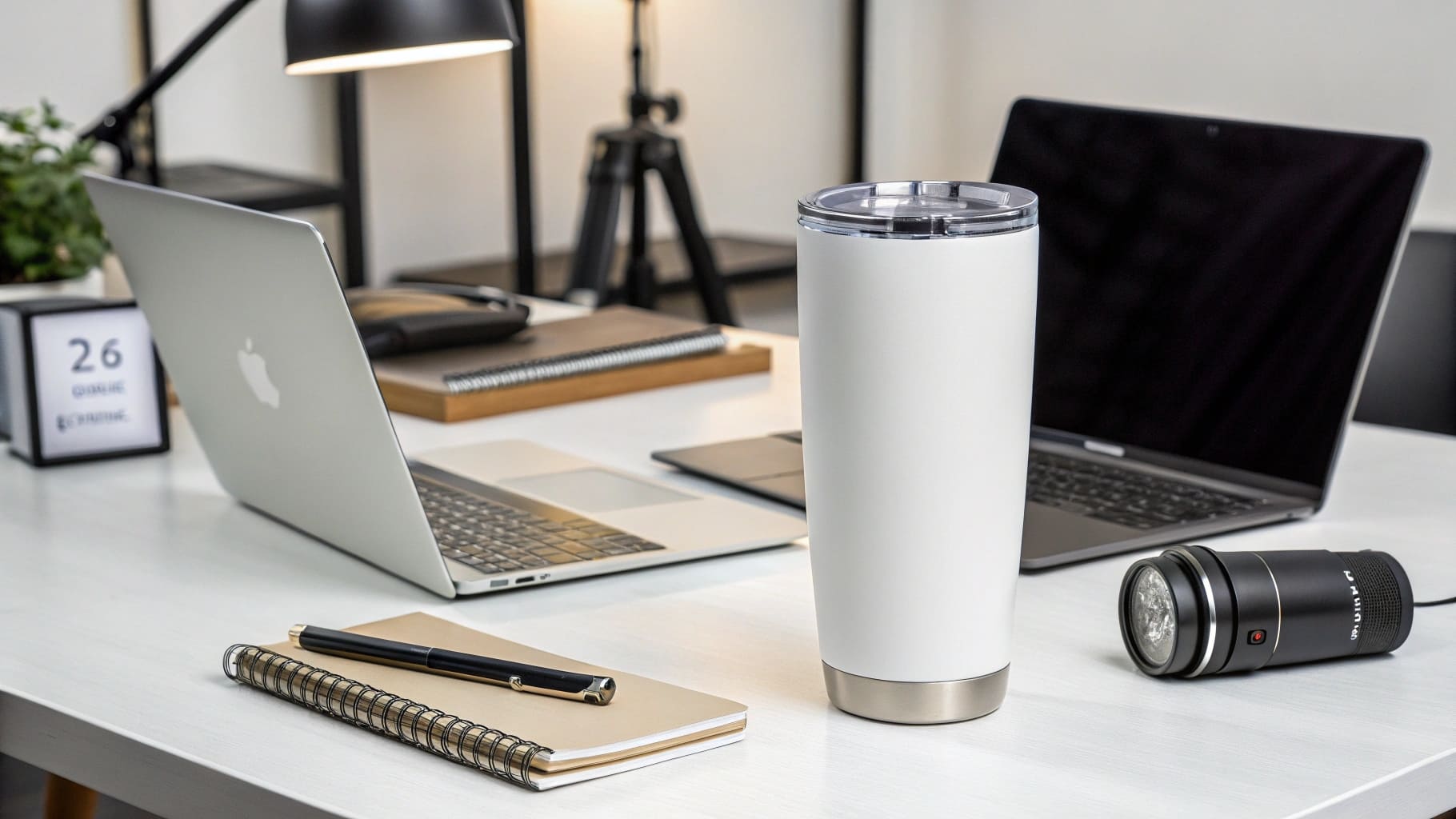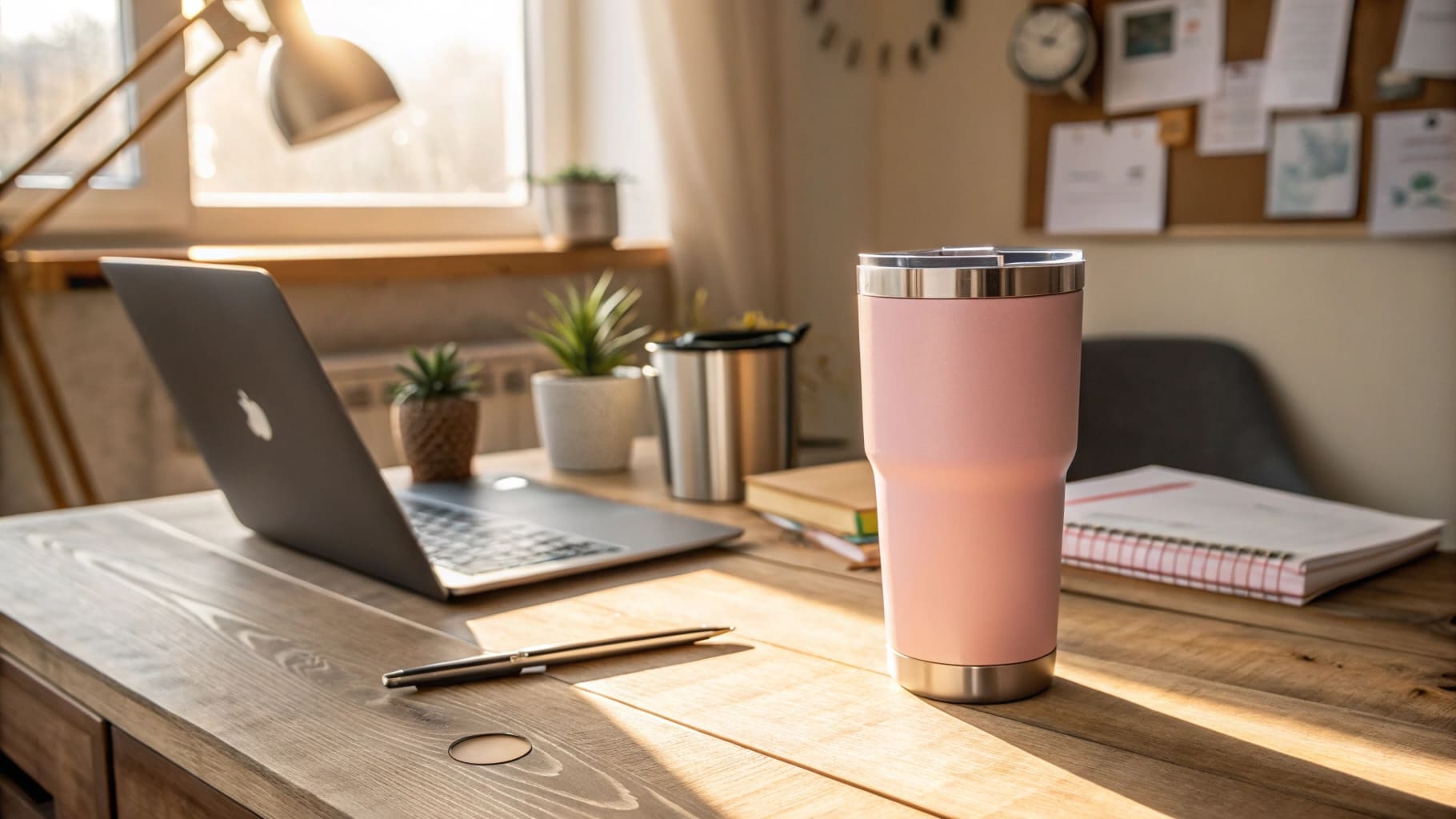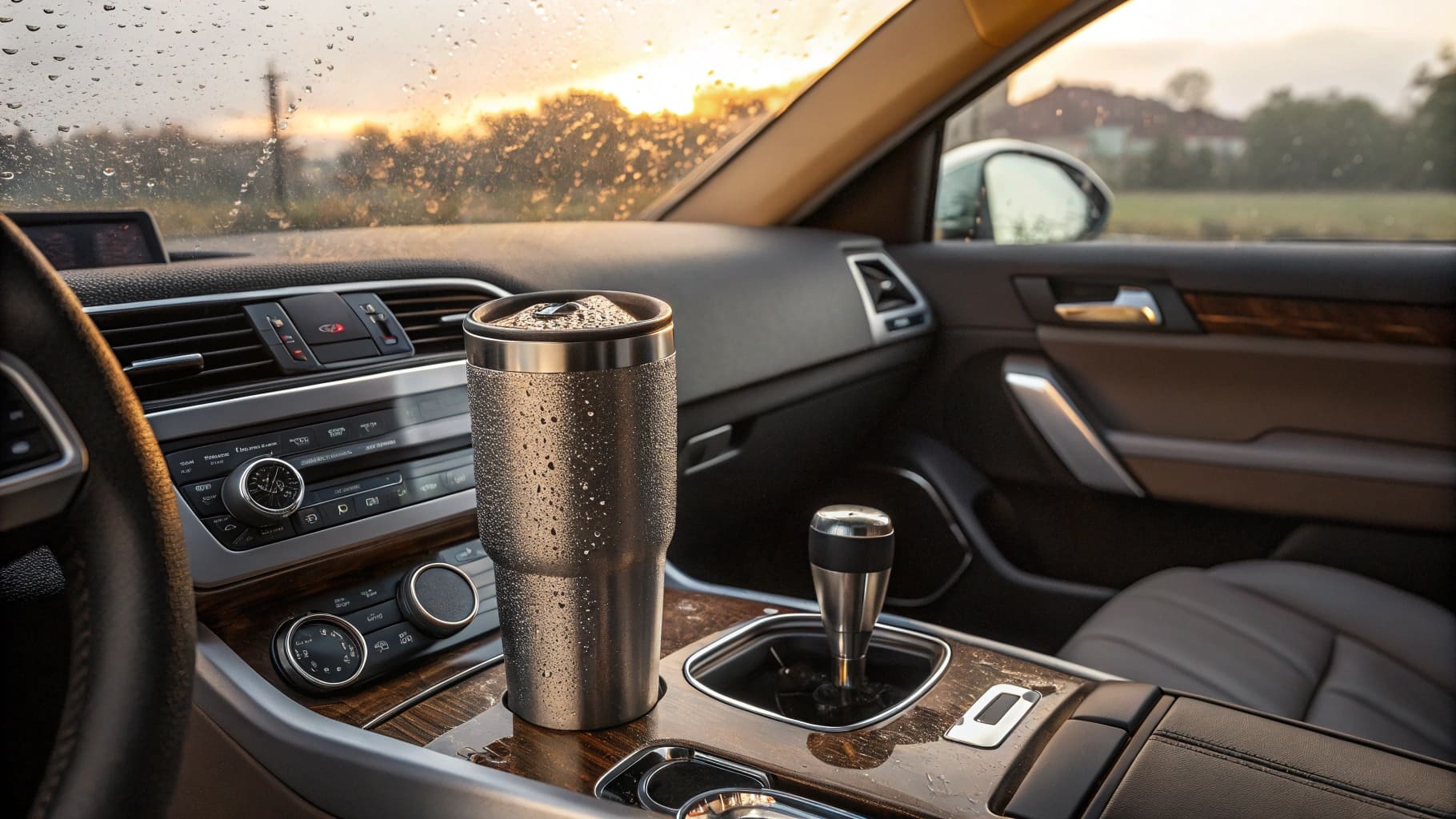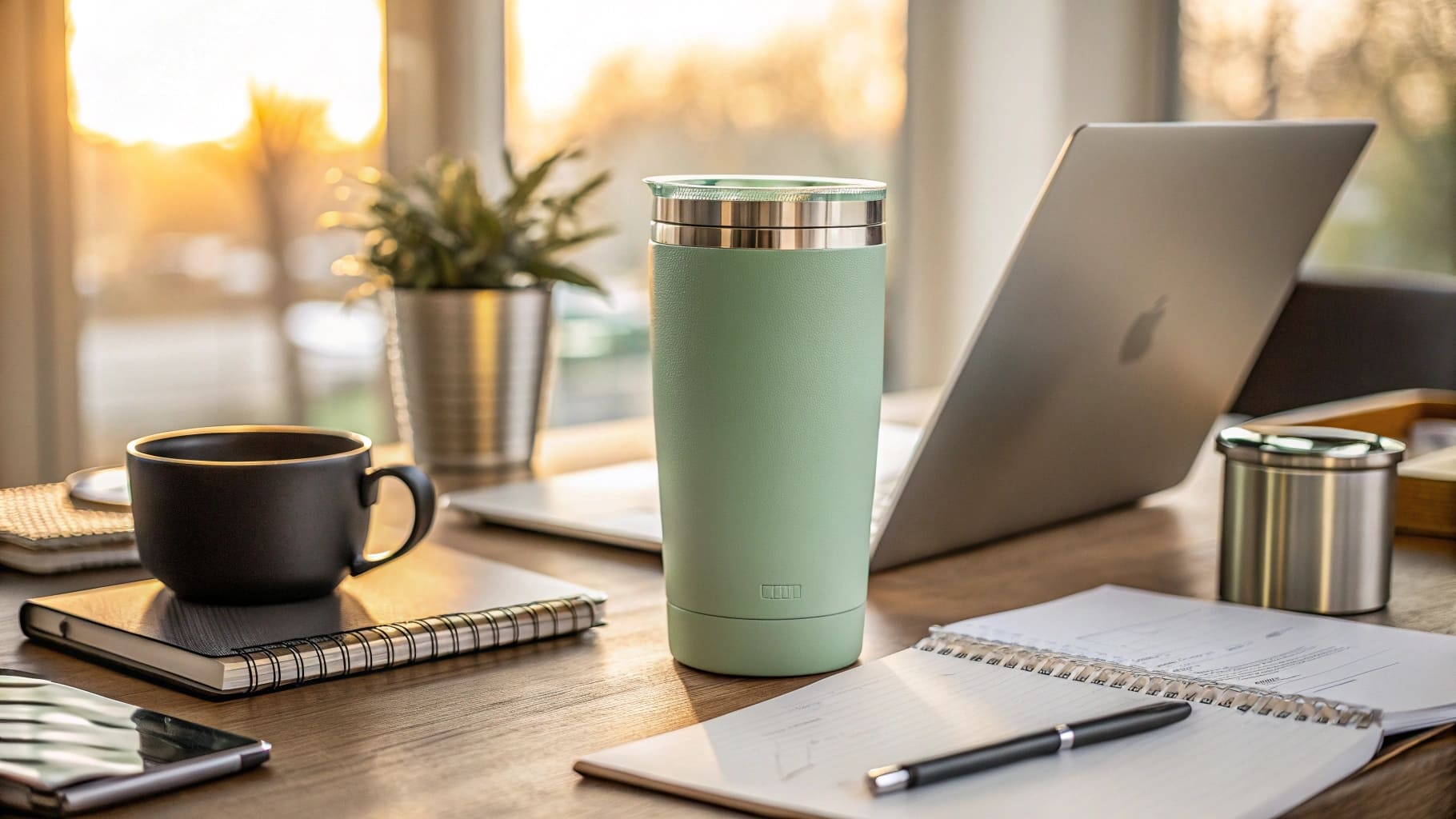Struggling to make your brand memorable? Generic promotional items often fall flat. Premium stainless steel mugs offer a distinctive, lasting impression, setting you apart.
You can differentiate your brand by choosing premium stainless steel mugs that focus on superior material quality, flawless construction, an odor-free user experience, and sophisticated printing. This approach directly elevates your brand's perceived value and commitment to excellence.

So, you're considering stainless steel mugs. But what makes them truly premium? These items can really make your brand shine if you pay attention to the details. Let's explore the key factors that can turn a simple mug into a powerful brand statement for clients like Mark Shenng, who value quality and a good impression.
Is Stainless Steel Good for Mugs?
Wondering if stainless steel is the right choice for your branded mugs? Concerns about taste or durability might hold you back. Actually, it's an excellent material.
Yes, stainless steel, particularly food-grade 304 (18/8), is very good for mugs. It’s strong, resists rust, doesn’t transfer flavors, and is safe for drinks, making it a reliable choice.

Stainless steel is a popular choice for drinkware, and for good reason. As someone who has been in the stainless steel products business for years with Icobottle, I've seen many materials come and go, but stainless steel consistently performs well, especially for B2B needs.
Key Advantages of Stainless Steel
Stainless steel offers several benefits that are hard to ignore.
First, it's incredibly durable. Unlike ceramic or glass, it won't easily break or chip if accidentally dropped. This longevity means your branded mug, perhaps for a company like Mark's in Canada, can be used for years, keeping your brand visible.
Second, it has excellent temperature retention. Double-walled, vacuum-insulated stainless steel mugs can keep drinks hot for my entire morning commute or cold during a long summer day. I remember during a particularly long trade show negotiation, my coffee stayed perfectly warm in my stainless steel mug, keeping me focused.
Third, it's a safe and hygienic material. Food-grade stainless steel doesn't react with beverages or leach harmful chemicals. This is a key selling point for health-conscious consumers.
Finally, it's an environmentally conscious choice because it's reusable and 100% recyclable, which appeals to increasingly eco-aware customers.
Common Types for Mugs
When I'm sourcing mugs for Icobottle, or advising clients, we mainly focus on two types:
- 304 (18/8) Stainless Steel: This is the industry standard for food and beverage applications. The "18/8" refers to its composition of 18% chromium and 8% nickel. These elements provide excellent rust resistance and durability. Most of our premium mugs use this.
- 316 Stainless Steel: This is a higher grade, often called marine-grade or medical-grade steel. It has added molybdenum, giving it even better corrosion resistance, especially against salts and acidic substances. While more expensive, it's the top choice for ultimate durability or for brands wanting to highlight the absolute best material.
Here's a quick comparison to help you decide:
| Feature | 304 (18/8) Stainless Steel | 316 Stainless Steel |
|---|---|---|
| Corrosion Resistance | Very Good | Excellent |
| Cost | Standard | Higher |
| Common Use | Most drinkware, kitchenware | Premium items, harsh environments |
| Food Safety | Excellent | Excellent |
| My Recommendation | Perfect for most premium branding | For ultra-premium or specific needs |
For most premium branding purposes, 304 stainless steel offers the perfect balance of quality, performance, and cost. It’s what I usually recommend to procurement officers. However, for an ultra-premium feel or if the mugs will be used in demanding conditions, 316 is a top-tier option.
Why Does My Stainless Steel Mug Smell?
Noticed an odd metallic smell from your stainless steel mug? It’s unpleasant and can ruin your drink. Understanding the cause is the first step to fixing it.
Your stainless steel mug might smell due to manufacturing residues, trapped moisture leading to bacteria, or oils and soaps from washing. High-quality steel and proper finishing processes usually prevent this.

A metallic smell can be a real turn-off, and it’s a concern I’ve heard from clients like Mark. He's very sensitive to quality, and an odor would definitely be a red flag. It's often not the steel itself, especially if it's good quality like 304. The issue usually stems from other factors.
Common Culprits for Odors
Several things can cause that unwanted smell in a stainless steel mug.
First, manufacturing residues are a common cause. Things like polishing compounds or machine oils can cling to the surface if the mugs are not thoroughly cleaned by the factory after production. Sometimes, this is more common with lower-cost suppliers who might try to save time or money on final cleaning and passivation stages.
Second, trapped moisture is a big one. If the mug, and especially complex lids with seals, isn't dried properly after washing, bacteria can grow. This growth is what creates those musty or unpleasant odors. I once left some tea in a sample mug overnight when I was testing a new design, and the faint smell lingered until I gave it a really deep clean.
Third, the smell can come from reactions with certain strong-tasting beverages or even from dish soap residue if the mug isn't rinsed well enough.
The Role of Material Quality and Finishing
The quality of the stainless steel and how it's finished play a huge role in preventing odors. Lower-grade stainless steel might be more porous or reactive, making it more prone to retaining odors or even imparting a slight metallic taste. More importantly, a finishing process called passivation is crucial. This chemical treatment removes free iron from the surface of the steel and helps create a passive, non-reactive oxide layer. This layer significantly enhances corrosion resistance and reduces the chance of the steel interacting with its contents. A well-passivated mug is far less likely to develop smells. When I discuss specifications with suppliers for Icobottle, I always emphasize the need for thorough cleaning and proper passivation.
My Experience with a Batch
I recall an instance a few years ago when we were vetting a new potential supplier. The initial samples looked good, but a few of the mugs had a faint, almost oily smell. We sent them back for analysis and traced the issue back to their final cleaning stage; it simply wasn't robust enough. It really highlighted how crucial every step of quality control is, even for seemingly small details like this. For a discerning buyer like Mark, who sells rebranded products in Canada, this kind of oversight by a supplier would be unacceptable and could damage his brand's reputation.
What Makes a Good Quality Mug?
Trying to define "good quality" for a stainless steel mug? It's easy to get confused by the many options available. Key factors clearly set premium apart from average.
A good quality mug uses superior raw materials like 304 or 316 stainless steel, features flawless construction, provides excellent insulation, has a comfortable design, and boasts a durable, odor-free finish.

For B2B buyers like Mark Shenng, who purchase products for rebranding and distribution, understanding what truly makes a "good quality mug" is vital. Their reputation depends on the quality of the products they sell. It’s about much more than just how the mug looks on a shelf.
Key Indicators of Quality
When I inspect samples for Icobottle or advise clients, here's what I look for:
First, material grade is absolutely paramount. As we've discussed, 304 (18/8) stainless steel is the standard for food-grade quality. Some cheaper mugs might use 201 stainless steel, which contains less nickel and more manganese, making it more prone to rust and retaining odors over time. I always insist on material certification from suppliers.
Second, examine the construction and finish. Are the welds, if any, smooth and almost invisible, especially on the inside? Is the surface, both internal and external, polished well and free of any blemishes, scratches, or sharp edges? A seamless interior is not only aesthetically pleasing but also easier to clean and more hygienic.
Third, the lid quality is often an overlooked detail but is crucial for user satisfaction. Does the lid fit securely and create a proper seal? Is the seal itself (usually made of food-grade silicone) robust and well-fitted? A leaky lid is one of the most common complaints I hear about inferior mugs.
Fourth, insulation performance is key for functionality, especially for travel mugs. True double-wall vacuum insulation will provide the best temperature retention. You can often get a feel for this by the weight of the mug and by tapping it – it shouldn't sound thin or tinny.
Beyond the Basics: The User Experience
A truly good quality mug also considers the overall user experience.
Ergonomics matter – is the mug comfortable to hold? Is the handle, if present, well-designed and sturdy? Is the lip of the mug smooth and shaped for pleasant drinking?
Ease of cleaning is another important factor. Mugs with overly complex shapes or very narrow openings can be difficult to thoroughly clean, potentially leading to residue buildup.
Finally, for branded items, the durability of any external coating or printing is crucial. A premium powder coat or high-quality printing will resist chipping, scratching, and fading, ensuring the brand message remains clear and professional for a long time. I always tell my team at Icobottle, we're not just selling a mug; we're selling an experience and a representation of our client's brand.
Here's a quick checklist I use:
| Quality Checkpoint | Look For | Why It Matters |
|---|---|---|
| Material Grade | Certified 304 (18/8) or 316 Stainless Steel | Durability, safety, rust & odor resistance |
| Construction & Finish | Smooth welds, seamless interior, no blemishes | Hygiene, longevity, aesthetics, safety |
| Lid Fit & Seal | Secure, leak-proof, food-grade silicone seal | User convenience, prevents spills, no leaks |
| Insulation Performance | True double-wall vacuum construction | Excellent temperature retention (hot/cold) |
| External Coating/Finish | Even, durable (e.g., powder coat), no sharp edges | Durability, user comfort, premium feel |
| Print/Logo Durability | Scratch-resistant, fade-resistant, crisp details | Brand longevity, professional appearance |
| Ergonomics & Design | Comfortable grip, smooth lip, easy to clean | Positive user experience, practicality |
Focusing on these aspects ensures that the stainless steel mugs you source will be a positive reflection on your brand and will satisfy discerning customers.
How Do You Stop Stainless Steel from Smelling?
Tired of that metallic tang or musty odor from your stainless steel mug? This common issue can be frustrating. Thankfully, there are effective ways to fix it and prevent it.
You can stop stainless steel from smelling by regularly cleaning it with simple household items like baking soda or vinegar. Always ensure it's thoroughly dried. Starting with a high-quality, well-finished mug also prevents odors.

Nobody wants their morning coffee or refreshing tea tainted by an unwanted smell from their favorite mug. Mark from Canada, being particularly quality-conscious, would definitely want clear solutions for this if any of his customers ever faced it. The good news is, it's usually easy to resolve and, even better, to prevent.
Immediate Cleaning Techniques for Existing Odors
If your mug already has a smell, a few common household items can work wonders. I've used these methods many times myself.
- Baking Soda Paste: This is my go-to first step. Make a paste of baking soda and a little water. Coat the inside of the mug with this paste, let it sit for about 15-30 minutes, then scrub gently with a soft brush or cloth and rinse thoroughly. Baking soda is fantastic at absorbing and neutralizing odors without scratching the steel.
- Vinegar Soak: White vinegar is another powerful odor remover. Fill the mug with equal parts white vinegar and hot water. Let it soak for at least 30 minutes, or even overnight if the smell is particularly stubborn. Afterwards, it's very important to rinse the mug extremely well with plain water to remove any lingering vinegar scent.
- Hot Water and Quality Dish Soap: Sometimes, especially if the smell is from oily residues or beverage remnants, a simple but thorough wash with hot water and a good quality, unscented dish soap is enough. The key here is to scrub well and then rinse, rinse, rinse!
Preventative Measures for Long-Term Freshness
Prevention is always better than cure when it comes to mug odors.
- Wash Regularly: This seems obvious, but it's important. Wash your mug soon after each use, especially if it held milk, sugary drinks, or strong coffee/tea. Don't let residues sit and dry.
- Thorough Drying is Crucial: This is probably the most critical preventative step. After washing, dry the mug completely. I prefer to air-dry them upside down on a rack to ensure all moisture escapes from the inside. Don't put the lid back on until both the mug and the lid are fully dry. Trapped moisture is a primary breeding ground for odor-causing bacteria.
- Avoid Abrasive Cleaners and Steel Wool: Harsh scrubbers or strong chemical cleaners (like bleach) can sometimes damage the passive layer on the stainless steel surface, potentially making it more prone to holding odors or even rusting in extreme cases. Stick to soft cloths, non-abrasive sponges, and gentle detergents.
The Supplier's Role in Odor Prevention
From a B2B perspective, especially for someone like Mark who is sourcing finished products, the supplier's manufacturing process is key to preventing odors from the start. As I mentioned before, ensuring the supplier uses a proper passivation process after manufacturing significantly reduces the likelihood of the steel itself contributing to any odors. At Icobottle, we make this a non-negotiable part of our quality control with our partner factories. This initial quality step in manufacturing minimizes many downstream issues for our clients and their end-users. Sourcing from a supplier who understands and guarantees these processes is a major advantage.
What is the Best Type of Mug Printing?
Want your logo to truly stand out and last on a stainless steel mug? Choosing the right printing method is vital. Some options offer a much more premium, durable finish.
For a premium look on stainless steel mugs, laser engraving provides a sophisticated and permanent mark. For vibrant, durable full-color designs, advanced UV printing is an excellent choice.

The way your brand is represented on the mug is just as important as the quality of the mug itself. For B2B clients like Mark, who are rebranding products for distribution in markets like Canada, the print quality directly impacts their brand perception and value. My experience at Icobottle, dealing with countless customization projects, confirms that certain methods align far better with a premium image and offer better longevity.
Popular Printing Methods for Stainless Steel
There are several common ways to get your logo or design onto a stainless steel mug:
- Laser Engraving: This method uses a concentrated laser beam to etch the design directly into the stainless steel surface or through its outer coating (like a powder coat). It creates a very durable, subtle, and often high-end, tactile look. The "color" of the engraving is typically the natural silver of the steel underneath or a darkened tone of the existing coating. It's permanent.
- UV Printing (Ultraviolet Printing): This technology uses UV lights to instantly cure specially formulated inks directly onto the mug's surface. It allows for full-color, vibrant, and highly detailed designs, including gradients and photographic images. When done with good quality inks and proper surface preparation/curing, it can be quite durable and scratch-resistant. This method has become very popular for its versatility.
- Screen Printing (Silkscreen Printing): This traditional method involves pushing ink through a stenciled mesh screen onto the mug. It's good for solid, bold colors and larger, simpler designs. It can be cost-effective for larger production runs, especially for one or two-color jobs. Durability depends heavily on the type of ink used and the curing process.
- Pad Printing: An inked silicone pad is used to transfer the design from an etched plate to the mug. It's excellent for printing on curved or slightly irregular surfaces and can handle smaller, intricate designs with one or more spot colors.
Comparing Durability, Aesthetics, and Use Cases
When I advise clients at Icobottle on the best printing method, I often break down the options based on their specific needs:
| Method | Durability | Aesthetics | Cost (Relative) | Best For |
|---|---|---|---|---|
| Laser Engraving | Excellent (Permanent) | Premium, subtle, elegant, often monochrome | Moderate to High | High-end branding, executive gifts, minimalist designs |
| UV Printing | Very Good | Vibrant, full-color, detailed, photographic | Moderate | Colorful logos, complex graphics, full wraps, personalization |
| Screen Printing | Good | Solid colors, bold designs, good coverage | Low to Moderate | Large volume orders, simpler 1-2 color logos, budget-conscious |
| Pad Printing | Good | Good for curves, multi-color spot designs | Low to Moderate | Intricate small logos, logos on non-flat areas |
For differentiating a brand with premium stainless steel mugs, I typically recommend laser engraving for its timeless sophistication and permanence, or high-quality UV printing for brands that require vibrant color and detailed graphics. These methods best reflect a commitment to quality and a premium feel. I remember a project where a client initially wanted screen printing for a very detailed, multi-color logo on a high-end powder-coated mug. We did a sample, and while okay, it just didn't have the crispness or premium feel. We then did a UV printed sample, and the difference was night and day; the client was thrilled with the vibrancy and perceived value UV printing added.
Matching Printing to Your Brand Image
Ultimately, the "best" method depends on your specific brand identity, logo complexity, budget, and the message you want to convey. If your brand is about understated elegance and longevity, laser engraving is often the perfect fit. If your brand is dynamic, modern, and colorful, advanced UV printing can achieve stunning results that last. It's about making a conscious choice that enhances the overall perceived value of the product and aligns with your brand strategy.
Conclusion
Differentiating your brand with premium stainless steel mugs means choosing quality materials, ensuring an odor-free experience, demanding excellent construction, and selecting the best printing for a lasting impression.

